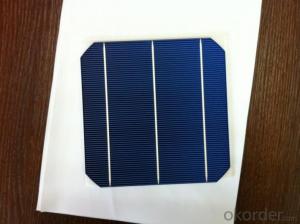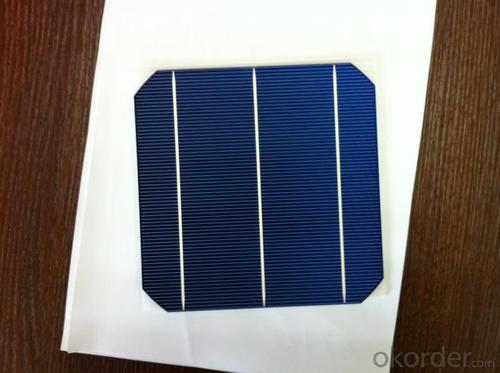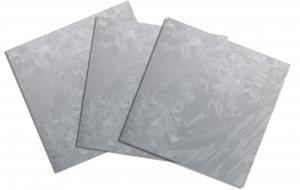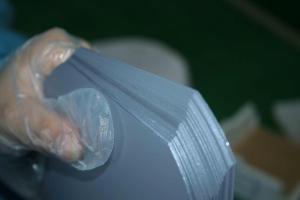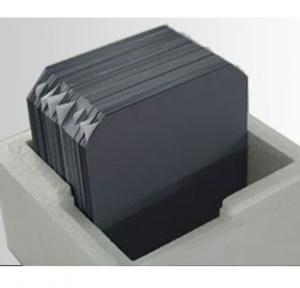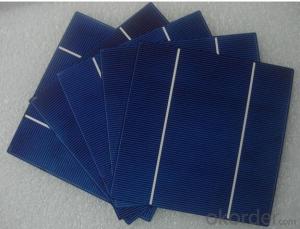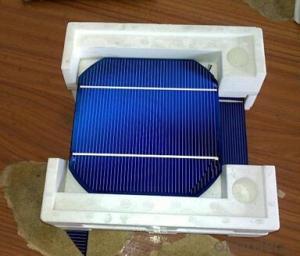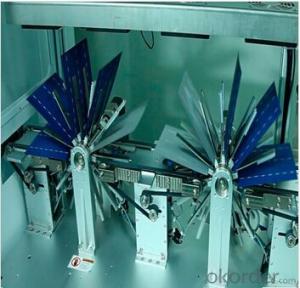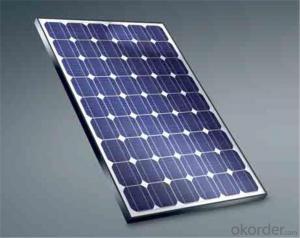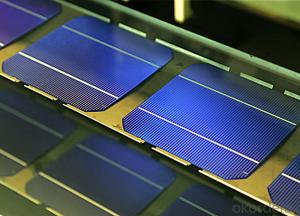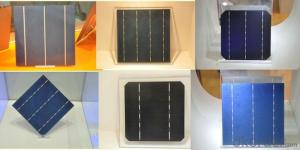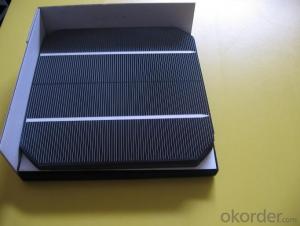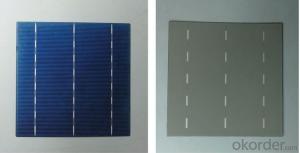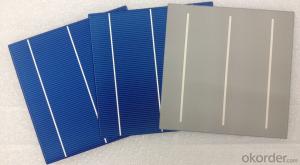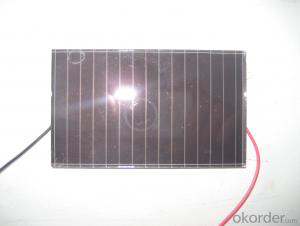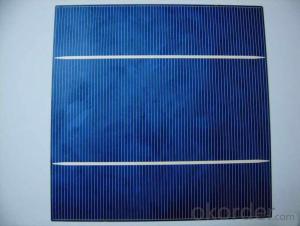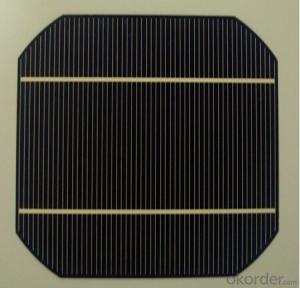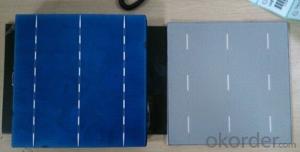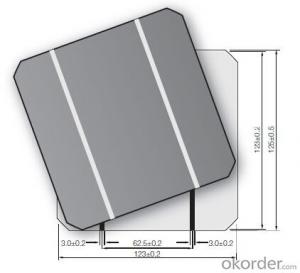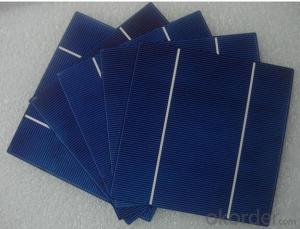Multicrystalline Silicon Solar Wafer - High Quality A Grade Poly/Monocrystalline 5V Solar Cell
- Loading Port:
- Shanghai
- Payment Terms:
- TT OR LC
- Min Order Qty:
- 1000 pc
- Supply Capability:
- 100000 pc/month
OKorder Service Pledge
OKorder Financial Service
You Might Also Like
Specifications
hot sale solar cell
1.16.8%~18.25% high efficiency
2.100% checked quality
3.ISO9001/ISO14001/TUV/CE/UL
4.stable performance
We can offer you the best quality products and services, don't miss !
POLY6'(156*156)
Polycrystalline Silicon Solar cell
Physical Characteristics
Dimension: 156mm×156mm±0.5mm
Diagonal: 220mm±0.5mm
Thickness(Si): 200±20 μm
Front(-) Back(+)
Blue anti-reflecting coating (silicon nitride); Aluminum back surface field;
1.5mm wide bus bars; 2.0mm wide soldering pads;
Distance between bus bars: 51mm . Distance between bus bars :51mm .
Electrical Characteristics
Efficiency(%) | 18.00 | 17.80 | 17.60 | 17.40 | 17.20 | 16.80 | 16.60 | 16.40 | 16.20 | 16.00 | 15.80 | 15.60 |
Pmpp(W) | 4.33 | 4.29 | 4.24 | 4.19 | 4.14 | 4.09 | 4.04 | 3.99 | 3.94 | 3.90 | 3.86 | 3.82 |
Umpp(V) | 0.530 | 0.527 | 0.524 | 0.521 | 0.518 | 0.516 | 0.514 | 0.511 | 0.509 | 0.506 | 0.503 | 0.501 |
Impp(A) | 8.159 | 8.126 | 8.081 | 8.035 | 7.990 | 7.938 | 7.876 | 7.813 | 7.754 | 7.698 | 7.642 | 7.586 |
Uoc(V) | 0.633 | 0.631 | 0.628 | 0.625 | 0.623 | 0.620 | 0.618 | 0.617 | 0.615 | 0.613 | 0.611 | 0.609 |
Isc(A) | 8.709 | 8.677 | 8.629 | 8.578 | 8.531 | 8.478 | 8.419 | 8.356 | 8.289 | 8.220 | 8.151 | 8.083 |
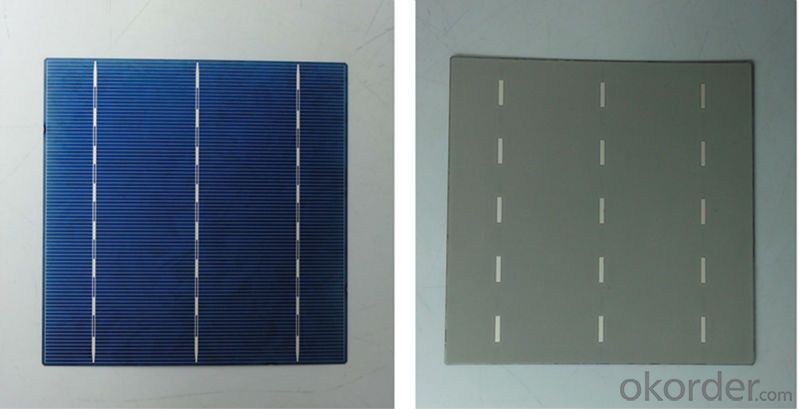
MONO5'(125*125mm)165
Monocrystalline silicon solar cell
Physical Characteristics
Dimension: 125mm×125mm±0.5mm
Diagonal: 165mm±0.5mm
Thickness(Si): 200±20 μm
Front(-) Back(+)
Blue anti-reflecting coating(silicon nitride); Aluminum back surface field;
1.6mmwide bus bars; 2.5mm wide soldering pads;
Distance between bus bars: 61mm . Distance between bus bars :61mm .
Electrical Characteristics
Efficiency(%) | 19.40 | 19.20 | 19.00 | 18.80 | 18.60 | 18.40 | 18.20 | 18.00 | 17.80 | 17.60 | 17.40 | 17.20 |
Pmpp(W) | 2.97 | 2.94 | 2.91 | 2.88 | 2.85 | 2.82 | 2.79 | 2.76 | 2.73 | 2.70 | 2.67 | 2.62 |
Umpp(V) | 0.537 | 0.535 | 0.533 | 0.531 | 0.527 | 0.524 | 0.521 | 0.518 | 0.516 | 0.515 | 0.513 | 0.509 |
Impp(A) | 5.531 | 5.495 | 5.460 | 5.424 | 5.408 | 5.382 | 5.355 | 5.328 | 5.291 | 5.243 | 5.195 | 4.147 |
Uoc(V) | 0.637 | 0.637 | 0.636 | 0.635 | 0.633 | 0.630 | 0.629 | 0.629 | 0.628 | 0.626 | 0.626 | 0.625 |
Isc(A) | 5.888 | 5.876 | 5.862 | 5.848 | 5.839 | 5.826 | 5.809 | 5.791 | 5.779 | 5.756 | 5.293 | 5.144 |

FAQ:
Q:How can i get some sample?
A:Yes , if you want order ,sample is not a problem.
Q:How about your solar panel efficency?
A: Our product efficency around 17.25%~18.25%.
Q:What’s the certificate you have got?
A: we have overall product certificate of ISO9001/ISO14001/CE/TUV/UL
- Q: Can solar silicon wafers be used in off-grid applications?
- Yes, solar silicon wafers can be used in off-grid applications. Solar panels made from silicon wafers are commonly used in off-grid applications as they can convert sunlight into electricity, providing a sustainable and renewable power source in remote locations without access to the grid.
- Q: Can solar silicon wafers be used in solar-powered smart cities?
- Yes, solar silicon wafers can be used in solar-powered smart cities. These wafers, which are made from highly purified silicon, are the key component in solar panels that convert sunlight into electricity. By utilizing solar silicon wafers, smart cities can harness renewable energy from the sun to power various infrastructure and devices, reducing reliance on fossil fuels and promoting sustainability.
- Q: How are solar silicon wafers affected by light-induced degradation?
- Solar silicon wafers are affected by light-induced degradation as they experience a decrease in their photovoltaic performance over time due to prolonged exposure to sunlight. This degradation is primarily caused by the presence of impurities in the silicon material and the formation of defect states known as "traps" within the solar cells. These traps trap charge carriers, reducing the efficiency of the solar cells and leading to a decrease in their power output.
- Q: How are solar silicon wafers affected by humidity and moisture?
- Solar silicon wafers are negatively affected by humidity and moisture. Exposure to high humidity or moisture can cause corrosion and oxidation on the surface of the wafers, which can impair their performance and efficiency. Moisture can also lead to the formation of water droplets or films on the surface, creating a barrier that reduces the amount of sunlight absorbed by the wafers. Additionally, humidity can increase the risk of electrical leakage and insulation failure in the solar cells. Therefore, it is crucial to protect solar silicon wafers from excessive humidity and moisture to maintain their optimal functioning.
- Q: Mainly want to understand its physical principles and processing technology, thank you
- Silicon is a semiconductor, of course, germanium is also, but silicon is easy to find, you go to the ground to see is the siliconPhysical principles on the complex, the first point of memory knowledge to say it, we generally say how much G, strictly speaking, GB, 1GB=1024MB
- Q: Can solar silicon wafers be customized for specific applications?
- Yes, solar silicon wafers can be customized for specific applications. The specifications of the wafers can be tailored to meet the requirements of various solar energy systems and applications, such as residential, commercial, or industrial. Customization can include adjustments in size, thickness, doping, and surface properties to optimize performance and efficiency for specific use cases.
- Q: Can solar silicon wafers be used in solar-powered electric fences?
- Yes, solar silicon wafers can be used in solar-powered electric fences. The wafers are used in solar panels to convert sunlight into electricity, which can then power the electric fence system.
- Q: Can solar silicon wafers be recycled?
- Yes, solar silicon wafers can be recycled. The recycling process involves the extraction and purification of silicon from used wafers, which can then be used to manufacture new solar panels. Recycling solar silicon wafers helps reduce waste and promotes a more sustainable approach to solar energy production.
- Q: How is the voltage output of a solar silicon wafer regulated?
- The voltage output of a solar silicon wafer is regulated through the use of a device called a charge controller. The charge controller ensures that the voltage output from the solar panel remains within a safe range by regulating the flow of current from the panel to the battery or grid. It prevents overcharging of the battery and protects the electrical system from voltage spikes.
- Q: What is the effect of impurities on the performance of solar silicon wafers?
- Impurities have a detrimental effect on the performance of solar silicon wafers. These impurities can interfere with the flow of electrons, reducing the efficiency of the solar cells. They can also cause defects in the crystal lattice structure, leading to decreased electrical conductivity and overall performance of the wafers. Therefore, minimizing impurities is crucial for maximizing the efficiency and reliability of solar silicon wafers.
Send your message to us
Multicrystalline Silicon Solar Wafer - High Quality A Grade Poly/Monocrystalline 5V Solar Cell
- Loading Port:
- Shanghai
- Payment Terms:
- TT OR LC
- Min Order Qty:
- 1000 pc
- Supply Capability:
- 100000 pc/month
OKorder Service Pledge
OKorder Financial Service
Similar products
Hot products
Hot Searches
Related keywords
